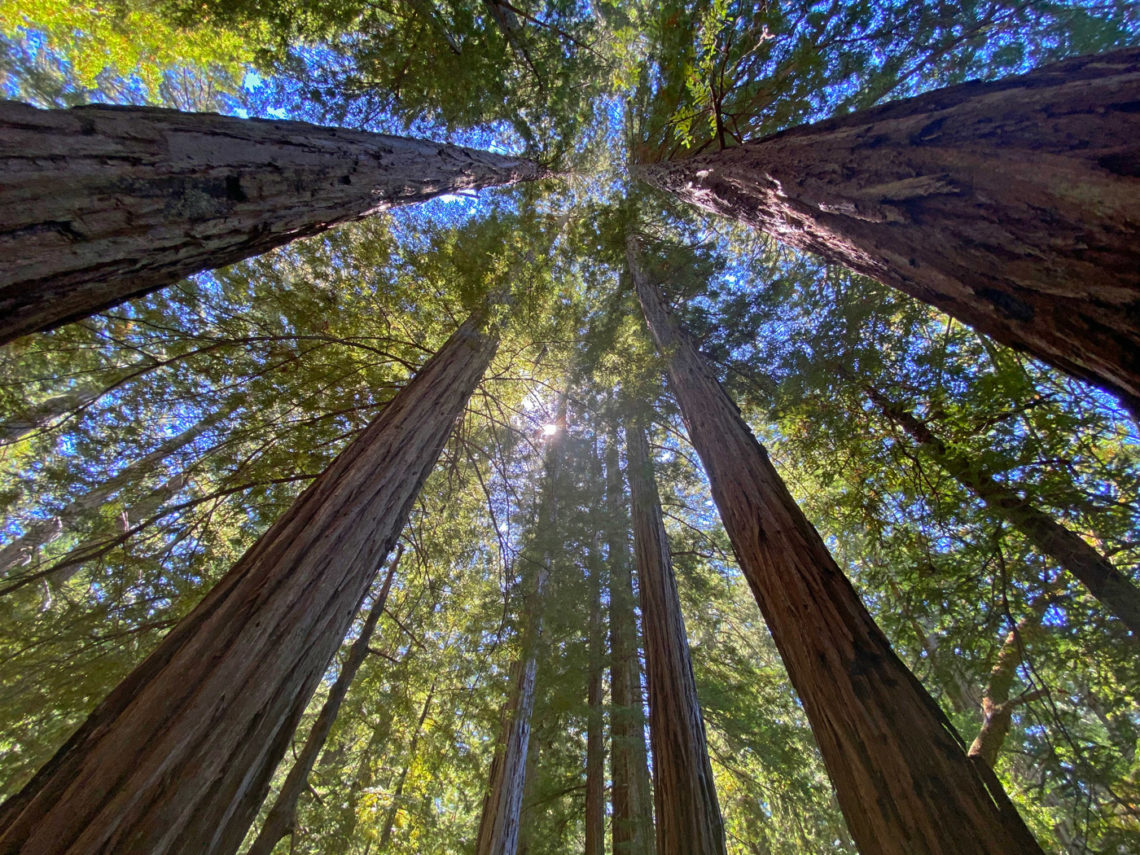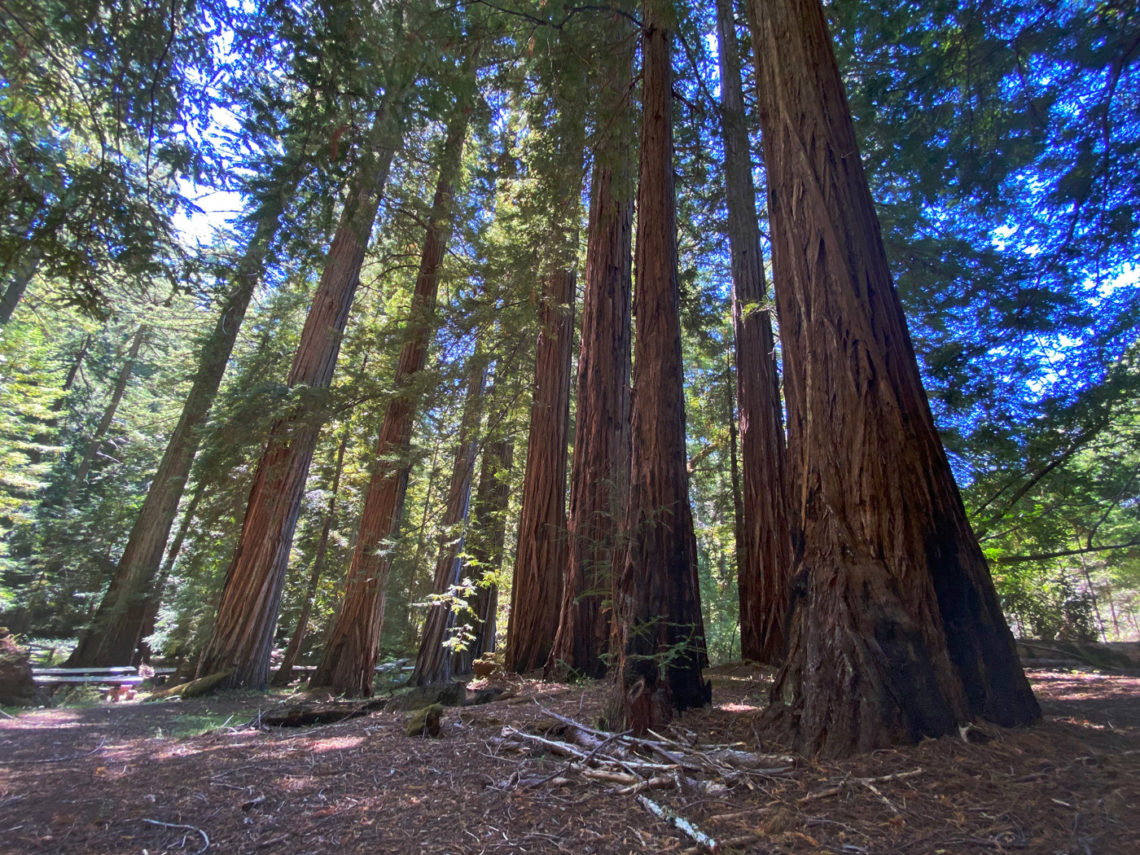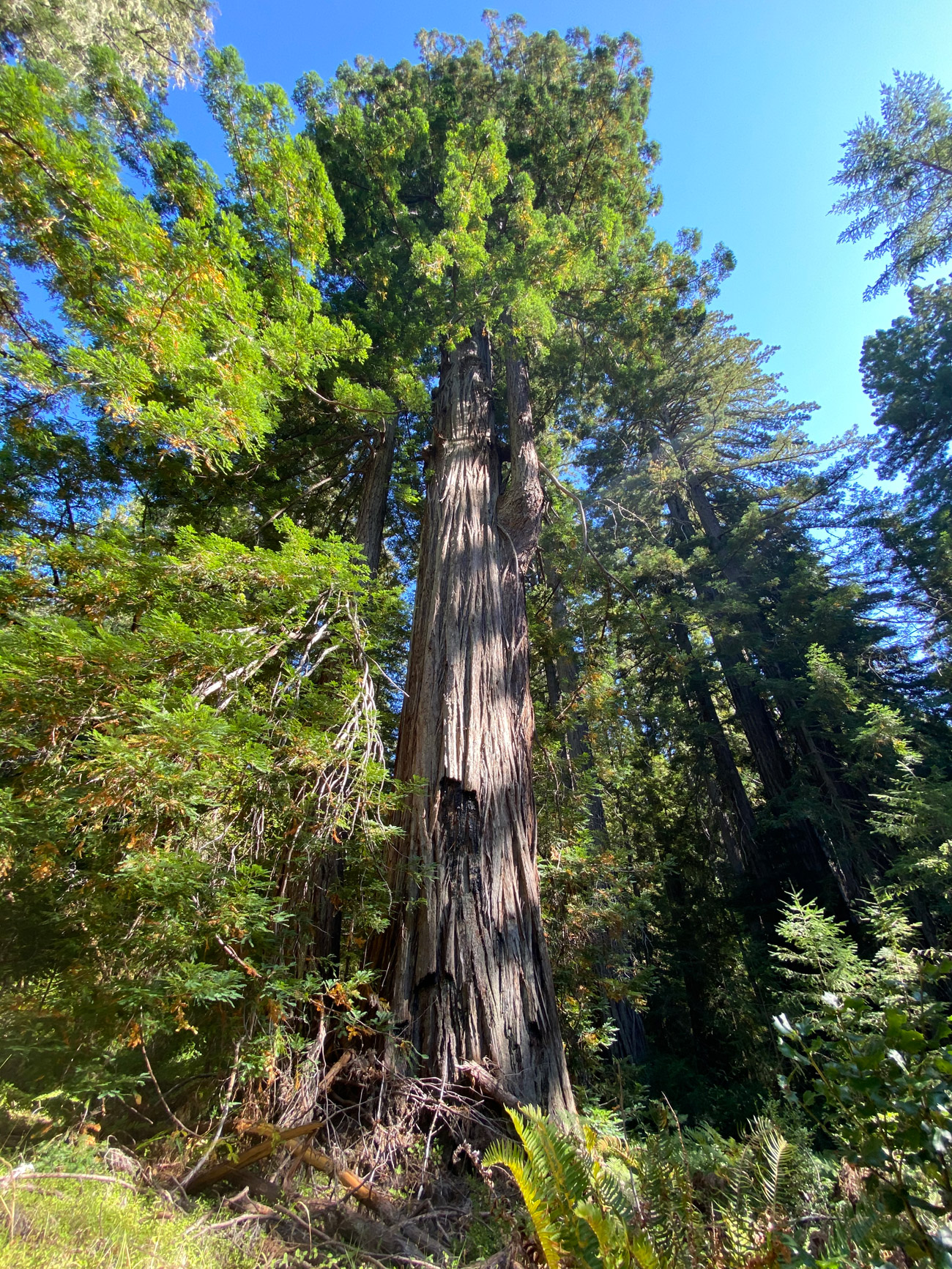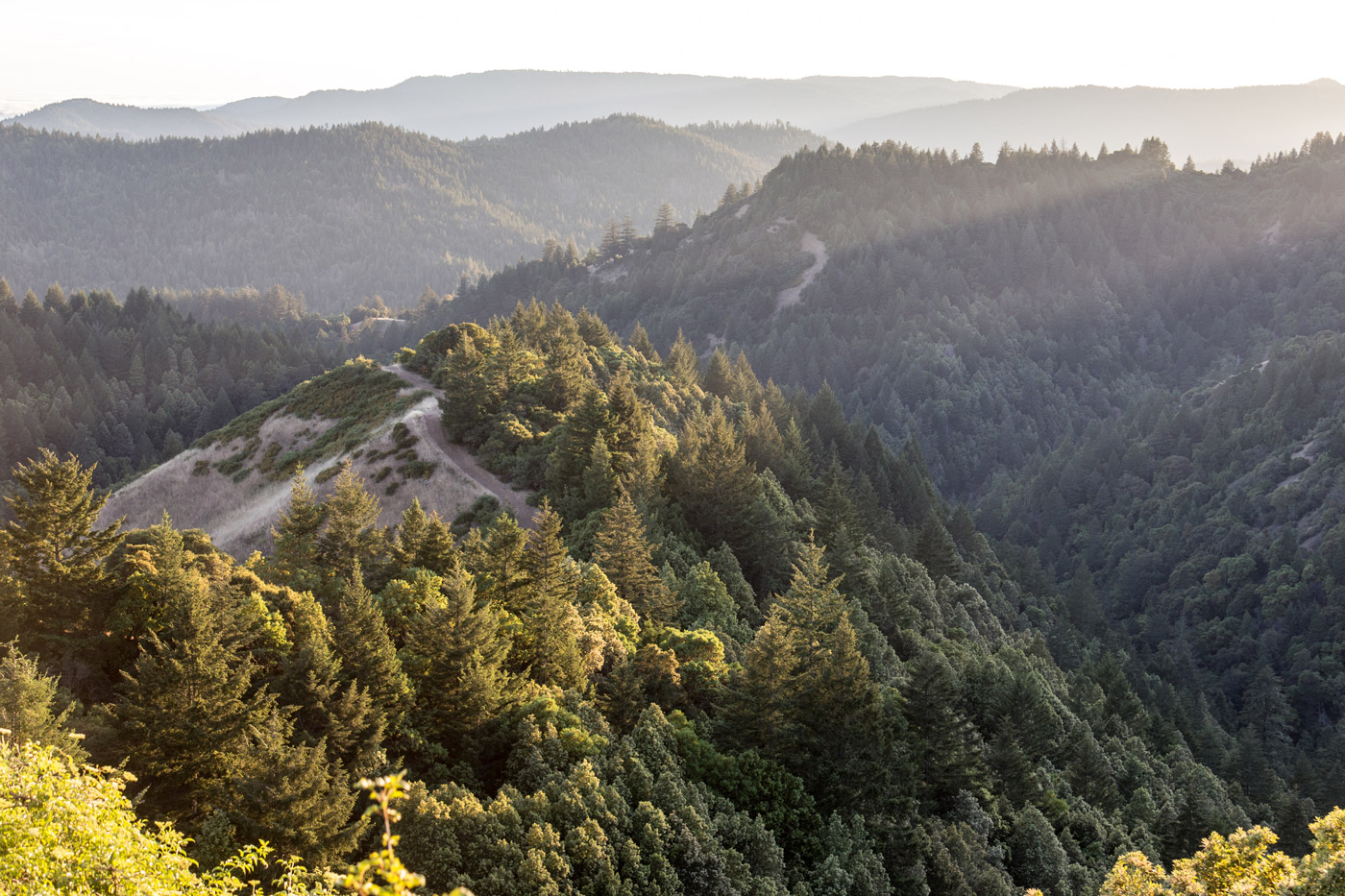A 14,838-acre landscape with nearly 1,000 acres of forest reserves, protected forever.

From the top of a 2,085-foot-high peak known as Flag Point overlooking a 360-degree panorama of lush forested canyons and mountains, expansive meadowlands, and the crowns of ancient redwoods backlit by the glow of an orange sunset, it’s easy to understand what’s at stake. This is Mailliard Ranch, a 14,838-acre undivided property in the scenic Anderson Valley of southern Mendocino County. It is the largest coast redwood forest still in private family hands.
In partnership with the Mailliard family, the League permanently protected this spectacular landscape through conservation easements. A conservation easement is a legal agreement that permanently limits uses of the land to protect its conservation values, no matter how many times the land gets sold or who owns it in the future.
Off Route 128 near Boonville, within the ancestral lands of the Central Pomo Tribes, the ranch serves as a buffer to accelerating development in the area and secures the stability of the regional forest ecosystem. Safeguarding Mailliard Ranch completes a puzzle of more than 82,000 acres of contiguous protected lands extending west from the Garcia River’s headwaters to the coast and south into northwestern Sonoma County. The ranch connects adjacent Mailliard Redwoods State Natural Reserve—donated by the family to the League for inclusion in the California State Parks system in 1954—and the Garcia River Forest, a nearly 24,000-acre forest owned and managed by The Conservation Fund for sustainable timber production, watershed restoration, and carbon sequestration.
This ideal connectivity has made the ranch a decades-long priority for conservation interests in California. With nearly 1,000 acres of reserves, including old-growth coast redwoods, mature mixed-conifer forest, and salmon-bearing streams, this land provides optimal habitat for a wide range of rare and endangered plants and wildlife, such as northern spotted owls, western pond turtles, Townsend’s big-eared bats, and golden eagles, as well as at least 159 native plant species.
This project fulfills key objectives of the League’s Centennial Vision: protecting remaining old-growth redwood forests, securing the redwood forests’ footprints, and restoring the forests’ ecological conditions. Completion of the project nearly doubles the amount of land that Save the Redwoods League has protected in Mendocino County.

Protecting a Family-Owned Forest
The Mailliards have been dedicated to protecting this special place since 1925 when the family first purchased the original parcel. Over the years, they expanded the property by acquiring neighboring parcels, stitching together a landscape that had been previously subdivided among dozens of small landowners. Once a sheep ranch that produced Merino wool, the property is now home to the Mailliard family’s small, low-impact cattle operation. There are 69 potential legal lots that the property’s numerous co-owners and future inheritors—multigenerational family members who are geographically dispersed—could ultimately sell to developers.
Instead, in 2015, the Mailliard family formalized their commitment to conservation and partnered with the League to grant conservation easements for the entire property—including two old-growth redwood groves and 28 miles of salmon-bearing streams at the headwaters of the Garcia River and in tributaries of the Navarro River.
In February 2021, the League closed the final phase of this project, protecting the entire west, middle, and east ranches of the property through three conservation easements. The Mailliards will retain ownership of the land and continue to steward it and run the working ranch, while the agreement safeguards all 14,838 acres from the threat of subdivision, development, and aggressive timber harvest.
The east ranch features the exquisite 58-acre old-growth Cathedral Grove. This remnant stand of towering redwoods evokes a primeval era, when the California coast was lush with forests of giant trees, mossy logs, and ferns sprouting up from soft beds of fallen redwood leaves. While there will be no public access to Mailliard Ranch or its protected groves, ensuring this forest stays forest for all time is important to the regional ecosystem and for the health of California’s natural landscapes, flora, and fauna. The Snow Mountain wildlife corridor, 7 percent of which is in US Fish and Wildlife Service-designated Critical Habitat for federally listed species, runs through the east ranch and is home to 12 plant species of special concern and eight animal species of special concern.

Climate Change and Fire Resilience
The Mailliards have been sustainably managing timber on the property for more than 90 years. Under the easement terms, they can continue their forest management activity on the ranch’s young second-growth working forest, utilizing low-impact management techniques such as selective harvesting. The easements will reduce by 50 percent the amount of timber that can be cut under the California Forest protection rules—and, by consequence, increase by that same factor the amount of carbon that will be stored by the forest.
Research through the League’s Redwoods and Climate Change Initiative has confirmed that old-growth coast redwoods store more carbon per acre than any other forest type ever measured. Our research has also shown that young coast redwoods in previously logged forests grow quickly, giving them the ability to store a substantial amount of carbon in their wood in a relatively short period. In addition to the property’s old-growth and working forests, its wetland and riparian habitats also capture significant amounts of carbon in marsh soils and aboveground vegetation.
Additionally, the easements will contribute to the region’s fire resilience. Residential development in the wildland-urban interface can dramatically exacerbate wildfire intensity and resulting firefighting costs, whereas mature redwood forests are among the most fire-resilient ecosystems in California. By restricting development and encouraging the return of mature forest conditions, the easements will reduce both future firefighting costs and structural losses by providing a buffer of healthy redwood forest.

Funding Landscape-Scale Protection
The League is deeply honored that the Mailliard family not only chose to partner with us to achieve permanent protection of this invaluable property, but also contributed a land value donation of $6.5 million toward the $24.7 million purchase price for the easements.
We are also grateful to our federal and state agency partners for bringing voter-approved public funding to bear on our shared conservation goals. The League received $4.75 million in grant funding from the State of California Wildlife Conservation Board (WCB) through Proposition 84, the Safe Drinking Water, Water Quality and Supply, Flood Control, River and Coastal Protection Bond Act of 2006; $4.3 million from CAL FIRE granted by the USDA Forest Service Forest Legacy Program; and $1 million from the California Natural Resources Agency’s Environmental Enhancement and Mitigation Program, established by legislation in 1989 under the California Streets and Highways Code with funding from the Highway Users Tax Account. These state and federal funds would not exist without voter support, demonstrating how critical the League’s supporters’ voices and votes are in helping us fund conservation projects.
The protection of Mailliard Ranch was made possible through public funding and by donors who supported the project through Forever Forest: The Campaign for the Redwoods. League donors contributed $8.15 million, including a $1 million grant from the Hind Foundation, a leadership gift from Ralph Eschenbach and Dr. Carol Joy Provan, a $250,000 match challenge offered by Justin Faggioli and Sandra Donnell, and grants from Walmart’s Acres for America program through the National Fish and Wildlife Foundation and the Nancy Eccles and Homer M. Hayward Family Foundation. The Mailliard family made a land value donation of $6.5 million.